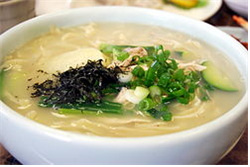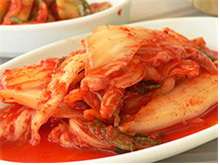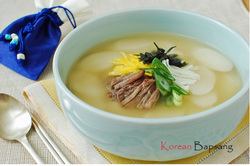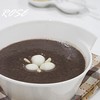
Today!! Let me introduce last Korean traditional dish consumed most often in winter.
Kalguksu (literally "knife noodles") is a Korean noodle dish consisting of handmade,
knife-cut wheat flour noodles served in a large bowl with broth and other
ingredients. It is traditionally considered a seasonal food because it's hot
food. Its name comes from the fact that the noodles are not extruded or spun, but cut.
kalguksu's history
The record of noodles can be found in documents of the Goryeo era, but the
descriptions are vague and the nature of the noodles isn't clear. In the 12th
century document Goryeo dogyeong, it is mentioned that noodles were only eaten
on special occasions, as wheat flour was very expensive, being imported from
China.
kalguksu's recipe
The noodles are made with dough from wheat flour and eggs, and sometimes ground bean
powder is added for texture. The dough is let to breathe, then rolled out thinly
and cut in long strips. The broth for kalguksu is usually made with dried
anchovies, shellfish, and kelp. Sometimes chicken broth would be used. In order
to obtain a rich flavor, the ingredients are simmered for many hours. The
noodles and various vegetables, most often zucchini, potatoes, and scallions are
added and boiled together. Usually seasoned with salt, the noodles are served
with garnish of choice

Today!! Let me introduce one of the most famous foods in Korea!!
It's Kimchi!! In winter in Korea, people make Kimchi and eat it until next winter.
Kimchi is Korea's national dish. It is so important to the nation's culture and cuisine that Koreans say "kimchi" when posing for photographs.
Traditionally, the greatest varieties of kimchi were available during the winter. In preparation for the long winter months, many types of kimjang kimchi were prepared in early winter and stored in the ground in large kimchi pots. Today, many city residents use modern kimchi refrigerators offering precise temperature controls to store kimjang kimchi. November and December are traditionally when people begin to make kimchi; women often gather together in each other's homes to help with winter kimchi preparations.
Early kimchi was made of cabbage and beef stock only. Red chili, a New World vegetable not found in Korea before European contact with the Americas, was introduced to Korea from Japan after the Japanese invasions and became a staple ingredient in kimchi, although its use was not documented until the 18th century.
Red chili pepper flakes are now used as the main ingredient for spice and source of heat for many varieties of kimchi.
Kimchi is made of various vegetables and contains a high concentration of dietary fiber, while being low in calories. One serving also provides over 50% of the daily recommended amount of vitamin C and carotene. Most types of kimchi contain onions, garlic, and chilli peppers, all of which are salutary. The vegetables used in kimchi also contribute to its overall nutritional value.

Happy New Year!
What do you usually eat in your home when it's Happy New Year?
In Korea, We always eat Tteokguk!!
Tteokguk is a soup made with sliced rice cakes, usually in beef broth. It's a traditional New Year's dish in Korea. "Tteok" means rice cake, and "guk" means soup. It’s made with garaetteok, which is unsweetened and shaped like a long cylinder. For the soup, garaetteok is sliced into thin oval shapes. The white oval shape symbolizes a bright and prosperous new year. Also, Koreans traditionally age another year on this day, rather than their birthday. It’s commonly said that one must eat a bowl of tteokguk to become one year older. Growing up in Korea, I always loved to eat long steaming garaetteok mom would bring home from a rice cake mill to prepare for the New Year's feast. She would wait a couple of days for the garaetteok to turn hard before slicing them into thin oval slices. These days, pre-sliced gareatteok is available all year around in any Korean grocery store, making the soup preparation much easier.Then... I think you are waiting for the recipe now!
Frist. In a large pot, bring the meat, onion, scallions and garlic to a boil in 14 cups of water. Reduce the heat to medium low, and skim off the scum. Simmer, covered, until the meat is tender enough for shredding, 1 to 1-1/2 hours. Remove the meat and cool. Discard the vegetables. Stir in soup soy sauce, salt and pepper to taste.Second. fry some eggs and slice them. Shred the cooled beef into thin 1 - 1 1/2-inch long strips and combine well with garlic, sesame oil, and salt and pepper to taste. Slice the scallion diagonally into thin strips. Roast the gim on a hot skillet. Cut into thin 1 1/2-inch strips with kitchen shears, or simply crush them with hands.Third. Add the rice cake slices and boil until soft in bowl. Ladle the steaming soup into individual bowls and garnish with the shredded beef, egg, scallion and gim strips.
Hey!!
How is your trip in Korea? Is it great? How about Korean foods? Do you know some
traditional foods in Korea? Let me show you some Korean traditional foods in
winter!!

I don't know well..about traditional Korean foods in winter. but, I think all
Koreans should know Patjuk because it's the most famous traditional Korean food
in winter.
In Korea, There is a day called Dongji. Dongji is a day that people think It's the
longest night in a year. Nowadays, Dongji isn't Korea's typical holiday. but,
long time ago, Dongji was second largest holiday next to Lunar New Year's Day in
Korea. In Dongji, people brought some redbeans and threw them to walls. People
thought that redbean's red color dispels ghosts so they will be well next year.
Eventually,
Patjuk has meaning of welcoming New Year and praying to God for
mercy.
Then... Let's make Patjuk!!
First, Wash rice and let it in water for 2 hours. and boil some red beans in
water.
Second, Mash boiled red beans and put them in bowl.
Third, Put washed rice in bowl with red beans. then, boil...
Patjuk
is very sweety and warm. In red beans, there are ingredients that make heats in body. So, In winter, It's very natural that people want to eat Patjuk!!
What do you think about Patjuk now? Do you want to eat it? Let's go to restaurant!




 RSS Feed
RSS Feed